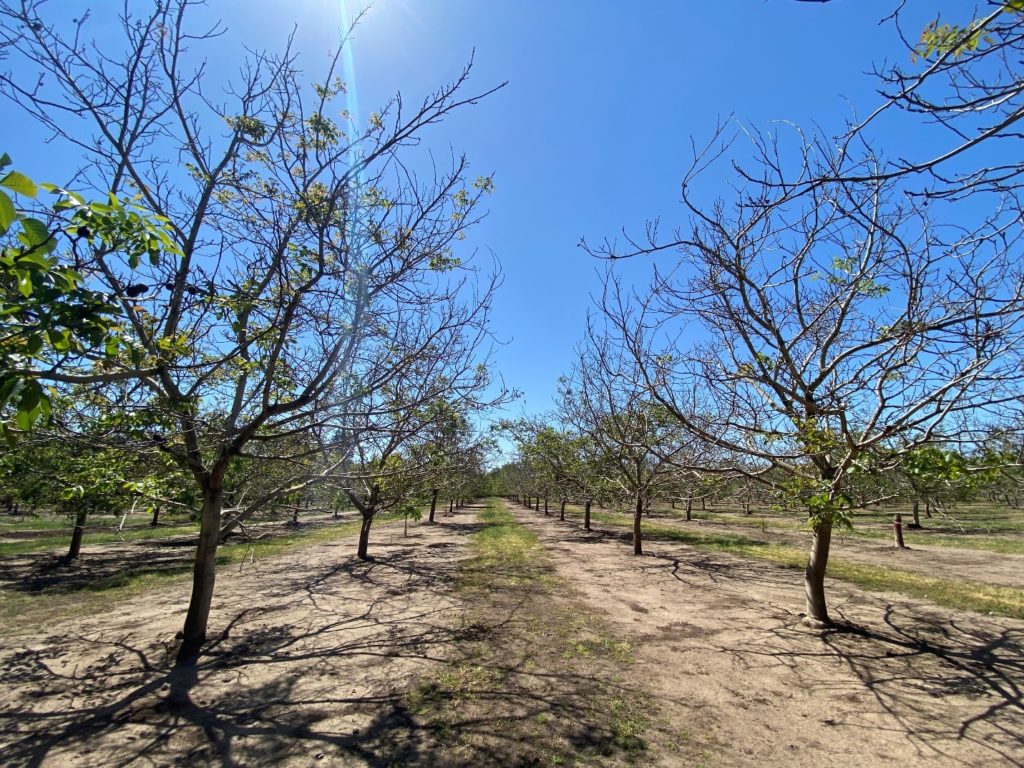
May 4, 2021November 2020: Another major autumn freeze in California walnuts
2020 is the third year in a row of walnut freeze damage in California. In 2018 there was a sudden autumn freeze event in November, during the Camp Fire, which we documented as trees failed to leaf out in spring, as well as the recovery later that spring, and one year later.
Some Sacramento Valley walnut growers, particularly those with orchards in cold spots that had damage from 2018, also reported 2019 freeze damage during the 2020 growing season. However, early observations indicate that the autumn 2020 freeze damage may be far more extensive than damage from the previous two years.
Why?
Our initial best guess for the cause of the tree damage we are observing in April 2021 are freeze events on the mornings of Nov. 10 and 12 2020 (table 1). Temperatures had previously been unusually warm in the first two weeks of November with highs around 80 degrees during the first week and only one morning of temperatures near freezing before temperatures dropped well below freezing on the 10th and 12th (figure 1).
The swing from daytime to nighttime temperature extremes may help explain the severe damage, according to UC Davis plant physiologist Maciej Zwieniecki. During these warm daytime temperatures, limbs contain starch, which does not provide protection from freezing. Slow cooling is needed to promote starch degradation into sugars, which protect against ice formation in cells. Our last November autumn freeze was a fast-cooling event with temperatures at times dropping 5 degrees per hour that interfered with starch being degraded into sugars, leaving trees more susceptible to cold injury. In addition, pomologists and biometeorologists believe that several nights of temperatures at or just above 32oF are critical in hardening walnut trees off and providing freeze tolerance ahead of subfreezing temperatures.

Table 1. Lowest air temperatures (oF) registered at Durham, Verona, and Manteca California Irrigation Management Information System (CIMIS) stations on November 10th and 12th, 2020.
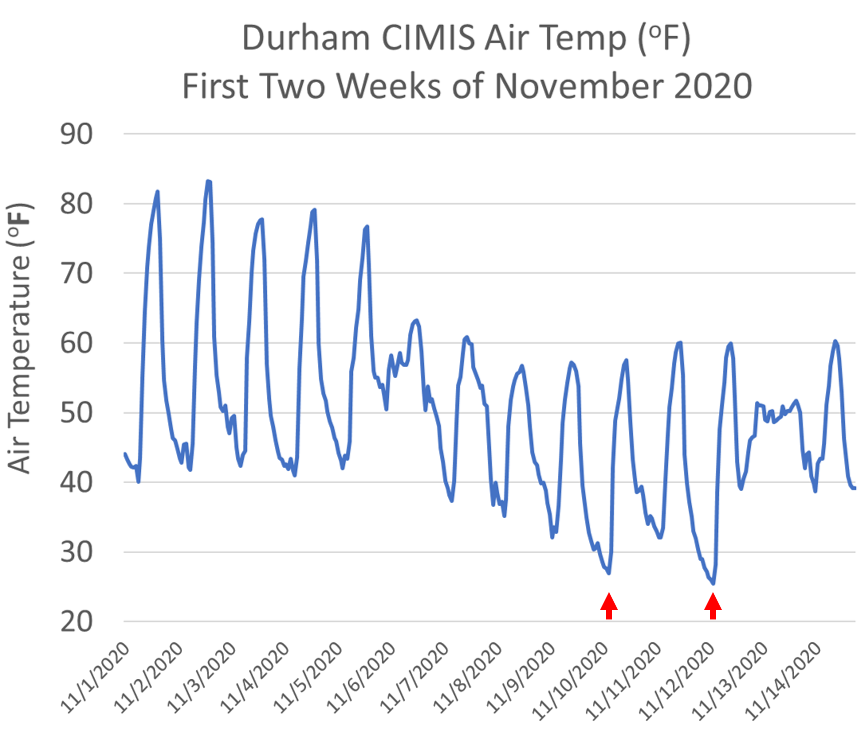
Figure 1. Durham California Irrigation Management Information System (CIMIS) station air temperature (oF) data for the first two weeks of November 2020, the temperatures were well below freezing during the mornings of the 10th and the 12th (see red arrows).
Why were some walnut orchards severely damaged while adjacent orchards were largely spared? As with our 2018 freeze, we believe one orchard specific factor that in many cases helps explain why some orchards were affected and others were not, is moisture at the top of the soil profile preceding the freezing conditions. We are still in the early efforts of surveying growers about their irrigation practices ahead of the 2020 freeze event. However, as with the 2018 freeze, it appears that most growers who last irrigated in early to mid-October faced more severe damage than orchards irrigated in late October or early November. We will be developing a survey to help determine what factors contributed to freeze damage.
What should you do with freeze damaged orchards?
- Wait and observe! With freeze damaged wood, budbreak can be quite delayed. If you suspect cold damage, do NOT prune out the damaged limbs in spring. The buds may be slow in opening or buds from deep in the bark may grow to rejuvenate the limb (photo 2). Wait until late June or July to prune out the dead wood that did not revive. New scaffolds that grow can be trained to replace the damaged wood.
- Protect exposed areas where buds are breaking from sunburn by painting the southwest side of trunks or limbs with tree paint or white latex paint 50:50.
- Delay the start of irrigation and monitor trees carefully using a pressure chamber and/or soil moisture measuring devices through the season. With less leaf surface, there is less transpiration. The pressure chamber is a direct measure of whether the trees need irrigation. Wait until pressure chamber readings are 2 to 3 bars below baseline to trigger irrigation in the spring, as well as to trigger subsequent irrigations. Overwatering freeze affected trees will damage roots and prevent canopy recovery.
- Reduce and delay spring fertilizer applications where cold damage is evident. Much of the nitrogen demand is from the crop, and therefore should be reduced in relation to the expected yield reduction.
- During mid-summer remove dead limbs and prunings from the orchard as they may be infected with Botryosphaeria (Bot) or Phomopsis (photo 3). In orchards where there is a history of Bot infection, consider applying a Bot spray by early July, whether or not deadwood removal is completed, to prevent disease spread.
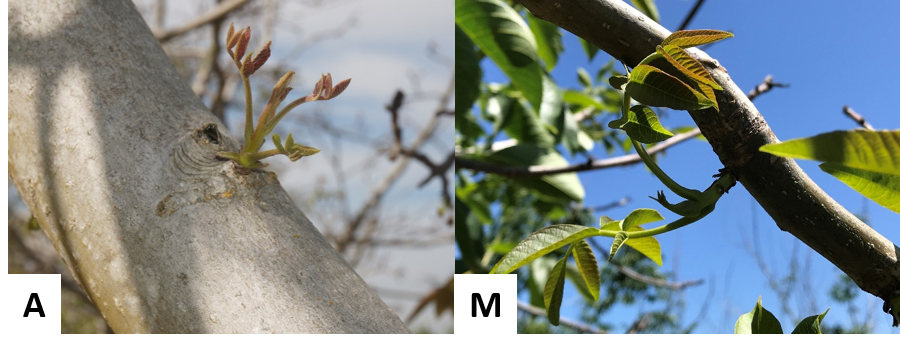
Photo 2. On otherwise blank branches, some adventitious buds were beginning to push on this Howard tree on April 19, 2019 following November 2018 freeze damage (A, by Janine Hasey). These adventitious buds appeared to continue to break later into spring (M, photo May 31st, 2019, by Luke Milliron).
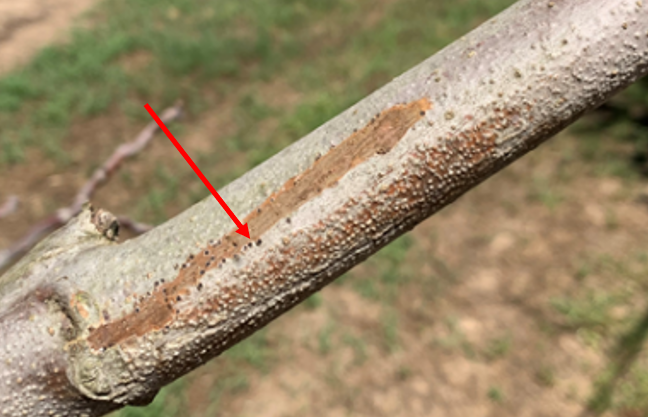
Photo 3. Freeze damaged limb from a Yuba City Howard orchard on June 6, 2019 following November 2018 freeze damage. Note raised “bumps” on bark and black pycnidia (see arrow) that produce spores below bark typical of Bot and Phomopsis (photo: Janine Hasey).
How to prevent future damage?
- For young and mature trees, finish nitrogen (N) applications by the end of August. For young trees: withdraw irrigation in September until a terminal bud (photo 4) is set on the trunk of young trees to harden the trees. After the terminal bud has set you can resume irrigation to avoid tree stress and defoliation, without the fear of pushing new growth.
- If there has not been adequate rainfall by the end of October, irrigate young and mature orchards so the soil is moist going into November. Rainfall adequacy can be determined by comparing rainfall totals with ET, and monitoring soil moisture levels by hand or with sensors. Trees with adequate soil moisture are better able to withstand low temperatures without damage than trees that are dry. Water conducts and stores more heat than air spaces.
- Continue to actively monitor soil moisture and freeze predictions in November. If a freeze is predicted and the soil is dry, it should be wetted 2 to 3 days prior to a freeze event to fill the air spaces so the soil will store more heat. The top foot is the most important and should be at field capacity (not too wet). If there is a dry surface crust, it will prevent the radiation of stored heat during the night. However, avoid water on the soil surface before a freeze since it will make the soil surface colder because of evaporative cooling.
- If freeze damage is suspected in the fall or winter, cut into the branches, and check the tissue for drying or browning (photos 5 & 6). Subsequent sunburn can further damage tissue on the southwest side of the tree. Paint the southwest side of damaged trees with 50% diluted (1:1 water to paint) white interior latex paint. Painting up to a week after the freeze event can decrease damage by half or more.
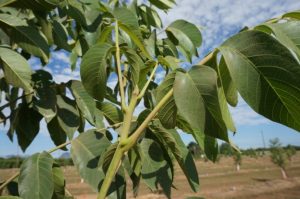
Photo 4. Withhold irrigation until a terminal vegetative bud sets on trunk (photo: Janine Hasey).
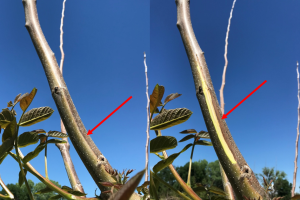
Photos 5 & 6. This characteristic distinct margin of dead and living tissue is typically seen in young orchard blocks. Shown both before (left) and after cutting (right; photos: Luke Milliron).
Acknowledgements:
We want to thank Maciej Zwieniecki, Mohamed Nouri, Kari Arnold, Astrid Volder, Joe Grant, Bruce Lampinen, Rick Snyder and many others for their assistance diagnosing the November 2018 and 2020 freeze damage.
– Luke Milliron, UCCE Farm Advisor Butte, Glenn, and Tehama Counties
Janine Hasey, UCCE Farm Advisor Emerita
Photo at top: Freeze-damaged Chandler almonds on-Paradox. Photo: UCCE







